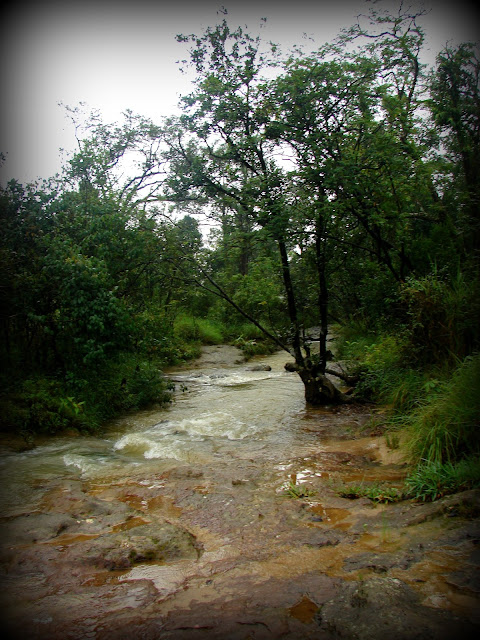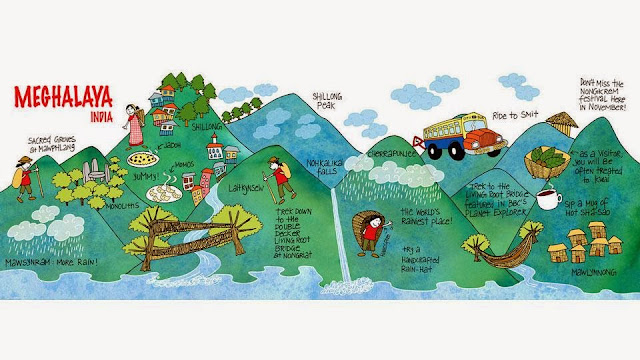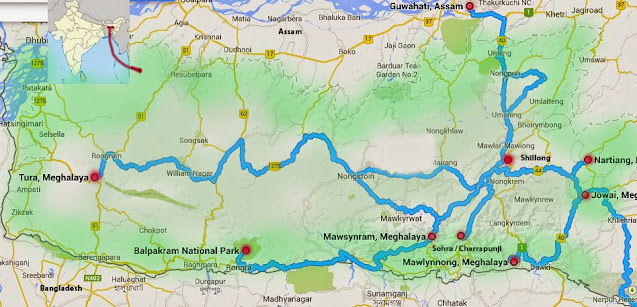 |
| On the way to Cherrapunji |
As a kid, I had this strange obsession wanting to visit Cherrapunji having read about it in school as the wettest place on earth (the position has now been gracefully taken over by Mawsyngram). My grandfather was posted in Shillong, hence we often visited the then Scotland of East almost every summer (Shillong is not the same anymore), and each time I voiced my last wish as if it were so, to visit the land of oranges, as it meant in the native language. Reaching Cherrapunji then was no less than an adventure with bad roads and limited means of access much unlike today, Hence, that wish kept getting postponed year after year until my grandfather moved out of Shillong, and the Cherranpunji visit got stalled for years. Finally, in 2014 D day arrived, and I got the opportunity to visit Sohra, the old name of Cherrapunji that has been reinstated by the Meghalaya government.
 |
| Places of interest close to Cherrapunji |
 |
| It was wet literally |
It was more like God wanted me to experience what the kid me had wished for many many years back - the wettest place on this planet, though that wasn't exactly what I had in mind after growing up :P. It drizzled the entire day with lucky sun breaks once in a rare while.
 |
| Cloud-covered lush green valleys |
The fog had shrouded the entire valley. Even driving was getting risky at times, the road was only faintly visible most of the journey. At times when the fog lifted and the drizzle stopped, I would hungrily savor the lusciousness of the panorama in front of my eyes. Wow!! could anyone even imagine there was so much green behind all that white ?!?
Enchanting! Dreamy !! Surreal !!! I could sit there for hours just to stand and stare and then disappear into the next misty spell.
 |
| Nohkalikai waterfall |
Luckily enough, I saw the Nohkalikai waterfall, the tallest waterfall in India. It wasn't in its best flow but still spectacular. The name Nohkalikai is associated with a tragic story.
Ka Likai who lived in Rangjyrteh, a village close to the waterfall, had a suspicious second husband. The man disliked her child from her first marriage. One day, when Ka Likai went to the forest to collect wood, her husband killed the child and cooked a delicious meal of her meat. He served it to K Likai when she returned hungry and tired. Without much thought she ate the food and turned to her husband, asking him what had he cooked? It was so delicious. The evil man smirked and said it was her child. The shock of the heinous deed and her own guilt of eating her own child turned Likai insane. Maddened she ran out of her house screaming for forgiveness and waving an ax at anyone who tried to stop her. She ran till the edge where the falls plunged off the precipice and threw herself along with the raging water. Ever since then, the fall has been called Noh Ka Likai ( from where Ka Likai jumped - Noh means jump in Khasi).
 |
| Site of the seven sisters waterfalls |
The scene at the Seven Sisters, Nohsngithiang Falls was veiled in white. We could only hear the gushing water. The locals said to wait till the wind blew the mist away. We waited for hours but the curtain refused to rise to our greatest disappointment :(
A photograph of the Nohkalikai at a restaurant near the falls shows its full flow right after monsoons around July. Calls for a return.
The same followed at the Mawsmai caves. We were told the water in the caves was pretty high, though many people still ventured in, so we decided to pass it. On the way, the fog had cleared a bit and we spent some time along this pretty streamlet.
Not before long, the fog curtained the magical greens, blues, browns, and all the many colors with stark white, as if to say, "That's it for now! come back again for the whole movie, this was only a curtain raiser" Of course, I definitely shall! for so much was missed! :) At times I think, I can rechristen Sohra as Kohra (mist in Hindi) :P

























































